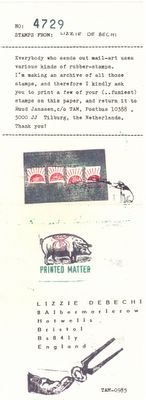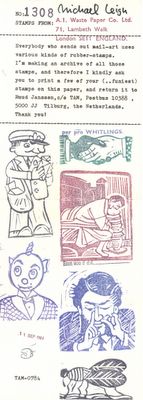Rubber stamps as an art form
source: Wikipedia
Rubber Stamp Art by Michael Dare
In the art world, there is also rubber stamp art. Sometimes the rubber stamps are self-made or even carved out of erasers. Today, companies in the US offer special, eraser-like rubber in larger pieces produced for this. This art is popular there, but virtually unknown in Europe. It is especially used by non-professional artists due to ease of use. It can mimic woodcuts, but is rarely used this way. The print from the carved rubber stamp is viewed as work of art on its own or one or several stamps are used to embellish a work of art with other components.
Also, other materials besides rubber may be used to produce a stamp. In fact woodcut and linocut are the same art using another carving material, but linoleum is much harder and so special tools are needed to work with it. In Europe linocut is widely used, other than rubber carving. While linocut is much used at schools or by hobby artists, woodcut is mostly restricted to professional artists because it's hard to do and takes long. Rubber carving material is available there now, but it's marketed as a children's toy and not widely used.
There are several possibilities to vary the look of those works. Paints, pigments and dye inks all create different effects, extending the use of rubber stamping from paper to fabrics, wood, metal, glass, and so on. Special ink pads can be purchased that allow for embossing and there are pens that can be used to ink stamp pads with a variety of colors for a multi-color look. All this creates possibilities for mixed media art of all sorts.
The print of a larger rubber stamp can be a work of art on its own right, and is often used as such. But it's also possible to use multible prints from the same or different rubber stamps on a piece of art to create a picture, or combine stamping with other art forms.
Of course the use of rubber stamps can be combined with other materials. The image may be embellished by the addition of chalks, inks, paints, fibers and a variety of other ephemera and embellishments.
Those works are often used in mail art or artist trading cards because they tend to be small and allow the making of series. The TAM Rubber Stamp Archive has a collection of prints of rubber stamps mail-artists used since 1983 (see link). Stamping is also often used in handmade cardmaking.
In addition, use of the stamping technique has become widely popular with scrapbooking. The variety of stamps available allow for different looks to any given page.






























